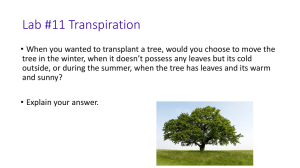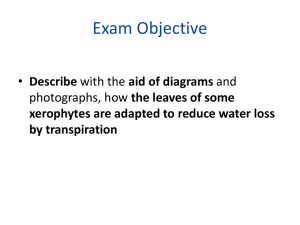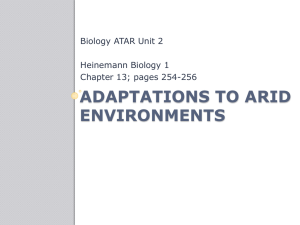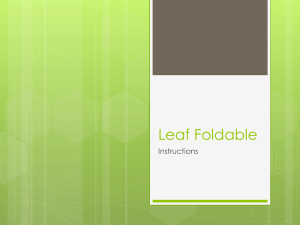22.1.1 Water Conservation in Plants
advertisement
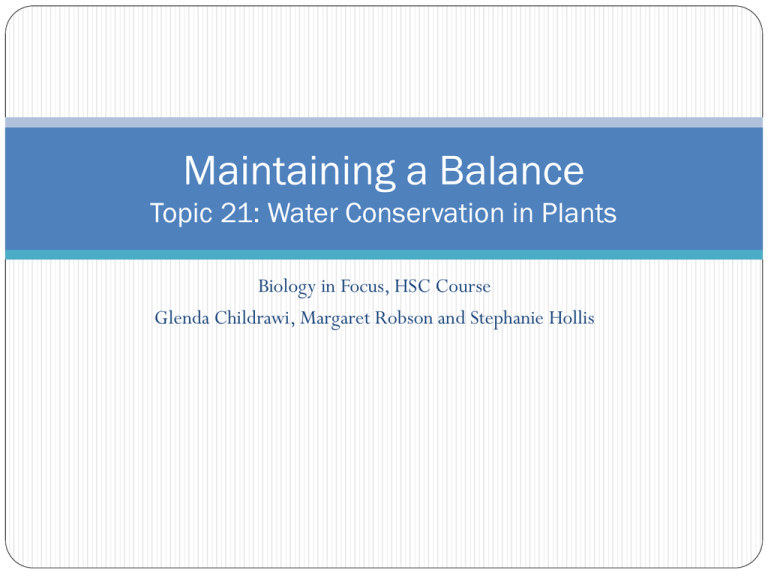
Maintaining a Balance Topic 21: Water Conservation in Plants Biology in Focus, HSC Course Glenda Childrawi, Margaret Robson and Stephanie Hollis DOT POINT Describe adaptations of a range of terrestrial Australian plants that assist in minimising water loss Problems Facing Plants The main form of water loss in plants is by means of transpiration – evaporation of water from the stomata of leaves. Transpiration serves two functions – it lifts water and dissolved ions up the stem to the top of the plants in a continuous transpiration stream and it is a form of evaporative cooling, a process that is essential in regulating temperature in plants. bfwatercycle.blogspot.com Problems Facing Plants Those plants that live in areas where water is in limited supply (usually hot, dry areas) must achieve a balance between how much water the plant can afford to lose for cooling purposes and the risk of dehydration. Xerophytes are plants that live in such areas and possess adaptations that equip them to achieve this balance and survive in their hostile environment. answerit.news24.com Problems Facing Plants Leaves of plants contain stomata and so they are the organs where most transpiration occurs. Generally, stomata are most abundant on the underside of leaves and are stimulated to open in the presence of light and/or excess heat in well hydrated plants. About 98% of water loss from plants occurs as a result of transpiration shoalwater.nsw.gov.au Problems Facing Plants Most of Australia is hot and dry, so water becomes a limited resource for plants, available in short supply or only in sporadic bursts. Many plants that live in hot and dry conditions display complex xerophytic adaptations, features which have evolved and allow these plants to minimise water loss while maintaining functions such as cooling the plant and photosynthesis. amodmag.com Problems Facing Plants Most of these adaptations are evident as modifications of leaves, but other organs may also show modifications. Xerophytes, such as some in Australian plants minimise water loss in four main ways. tasteaustralia.biz 1. Reducing Internal Temperatures Some plants have developed structural features and physiological mechanisms to reduce their internal temperature, allowing the plants to use less water for evaporative cooling, but still keep their temperature within the correct range for metabolism. chemical-engineering.co Reducing Internal Temperatures For example: The saltbush has waxy leaves that reflect heat and light Eucalypts and banksias have coarse, leathery leaves with a thick cuticle to protect them from excessive sunlight. Both of these features also ensures that all the epidermal cells are waterproof, preventing loss of water by evaporation from these surface cells to the outside. anbg.gov.au 2. Reducing Exposure to Sunlight Plant organs that have the most abundant stomata have the greatest rates of transpiration. Some plants reduce the exposure of stomata to light by: Changing the orientation of leaves so that stomata are not exposed to direct sunlight. Reducing the surface area of organs that have highest proportion of stomata The complete loss of transpiring plant organs. en.wikipedia.org Reducing Exposure to Sunlight For example: Plants like Hakea and Acacias (wattles) have leaves that become reduced in size, where each leaf if divided into leaflets. This reduces surface area. Reduced size of flowers or having no petals. Acacias have small clustered flowers, reducing the energy and water required to produce them. Shedding leaves; River gum Orientation of leaves; Eucalypts oznativeplants.com 3. Reducing Water Gradient The difference in water concentration between the plant and the surrounding atmosphere determines how much water is lost by transpiration. On a hot, dry day, the water concentration in the air is much lower than the internal tissues of the leaf and so more water is lost by transpiration than on a cooler or more humid day. flickriver.com Reducing Water Gradient Since plants cannot change the overall external environment, many have adaptations that allow them to create their own smaller ‘microclimate’ in the air immediately surrounding each leaf. britannica.com Reducing Water Gradient Structures such as hairy leaves or rolled leaves trap water in the immediate vicinity and in this way they keep air around the plant humid by preventing the moist ait being swept away by dry air currents and they also create a barrier for evaporation. flickr.com Reducing Water Gradient Sunken stomata or stomatal pits occur in Hakea and in the cladodes of she-oaks. The actual stoma (breathing pores) are lower than the main surface of the leaf and this allows moist air to be trapped in the pit, therefore reducing the difference in water potential immediately outside the stoma (in the pit) and inside the leaf. vcbio.science.ru.nl Reducing Water Gradient Epidermal hairs trap a moist layer of air, resulting in a smaller difference between the concentration of water in the leaf tissue and the water vapour in the layer of air trapped by the hairs. For example, the coastal banksia has hairs on the under-surface of leaves. sydney.edu.au Reducing Water Gradient Porcupine grass has curled/rolled leaves which enclose a microclimate of humid air to reduce the difference in water potential. These adaptations allow plants to keep their stomata open for a longer period of time, as there is not as much water being lost and so gaseous exchange for photosynthesis can occur freely. flickr.com 4. Water Storage Some plants like the Calandrinia, called succulents, have adaptations such as fleshy stems or leaves which are able to swell up and retain moisture when it is available; they then survive by using this moisture during dry periods. growinggroundsfarmsm.blogspot.com Water Storage Australia has some succulent species, including the desert plant Calandrinia (parakeelya), an important food for Aboriginal people. The leaves provide an excellent source of moisture in desert environments and were eaten as a green salad leaf. The word ‘parakeelya’ was derived from the word ‘periculia’, an Aboriginal name for the bread-like seed meal that is made from the cooked seed. ausemade.com.au Activity -Students to complete DOT Point 3.15


